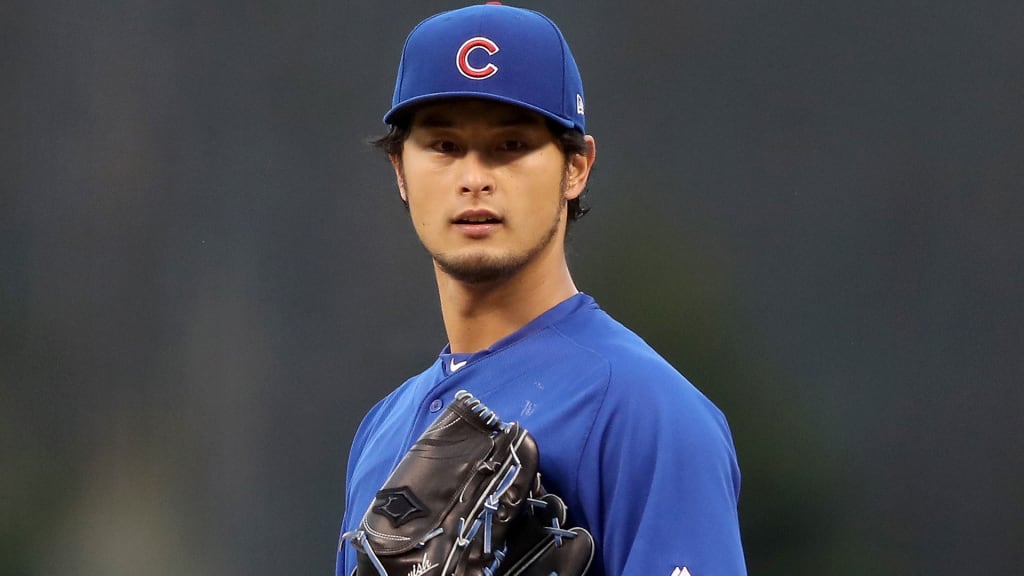
Each week on the Statcast™ Podcast, hosts Mike Petriello and Matt Meyers dig into the world of Statcast™ and advanced metrics, exploring the most important topics in baseball through the lens of the groundbreaking Statcast™ technology. Download, subscribe and help others find the show by leaving a rating and review on iTunes or your favorite platform.
What's wrong with Yu Darvish? That's the question that Cubs fan have been asking this month, as their big-ticket starting pitching acquisition -- and, notably, Jacob Arrieta replacement -- has gotten off to a slow start, with a 6.86 ERA through his first four outings. It's been especially rough the past two times out, as Darvish has allowed nine earned runs while failing to get through five innings in losses to the Braves and Rockies.
Darvish gets a chance to redeem himself on Friday against the first-place Milwaukee Brewers, who have won eight straight entering Thursday. Can he? His tough April was a topic of this week's Statcast™ podcast, as we dug into what the data says about the unexpectedly poor outings from a longtime ace.
The last we saw of Darvish in 2017, he was having a pair of awful starts for the Dodgers in the World Series, though that did follow a pair of good postseason starts and generally good work for Los Angeles down the stretch after being acquired from Texas. Two starts, even on the biggest stage, shouldn't take more importance than several years of ace-like quality. Still, based on what happened in the Fall Classic and the size of the $126 million contract Darvish signed with Chicago, he could have used a fast start.
Now, Darvish did throw effectively against Milwaukee on April 7, striking out nine over six one-run innings. But digging into the numbers, there's some pretty clear warning signs.
His strikeout rate is down.
Darvish struck out 31.7 percent of hitters in 2016, the second-highest rate of any pitcher with at least 100 innings pitched. Last year, that dropped to 27.3 percent, still above average but now 18th best. This year, he's down to just 22.8 percent. Darvish hasn't thrown enough innings to qualify for the leaderboards, but if he had, that would be 44th overall. Strikeouts in baseball are going up, but for Darvish, they're going down.
His walk rate is up.
Darvish consistently walked just under eight percent of hitters in both 2016 and '17. That's fine; nothing to see here. But this year, that's all the way up to 12 percent. So now we've got fewer strikeouts and more walks, and you can see where some of the problems are coming from. Why is this happening? Because…
His chase rate is down.
If there's a single culprit, it's this. There's almost nothing more beneficial to a pitcher than getting a hitter to swing at pitches outside the zone, because they're more likely to be misses or lead to poor contact. If you're wondering if this matters, note names on the Top 10 in 2016-17 at getting swings outside the zone were Masahiro Tanaka, Noah Syndergaard, Zack Greinke, Corey Kluber, Clayton Kershaw and Max Scherzer. Yes, it matters.
Darvish got a consistent 32 percent chase rate -- that is, nearly a third of pitches he threw outside the zone got swings -- in 2014, '16 and '17. This year? That's down to 23 percent. His once legendary slider, which once induced swings nearly half the time outside the zone, now has a chase rate of just 25 percent. It's been hit hard, with a line against of .269/.321/.654.
So what's the good news? There is good news.
First of all, Darvish's velocity isn't down, staying steady on his fastball at 94.2 mph, after 94.3 last year and 93.9 the year before. He's not really being hit harder, as his average exit velocity has dropped from last year's 85.7 mph to 84.8 mph, and at a lower launch angle, dropping from 13 degrees last year to 11 degrees this year.
There's definitely cause for concern about Darvish, especially after the way his slider got lit up by Houston last October (and November). But all hope is hardly lost, obviously, because the velocity is still there. The problem is if the command isn't, and if Darvish can't get hitters to go after the slider. Hittable in-zone fastballs tend to be hittable.